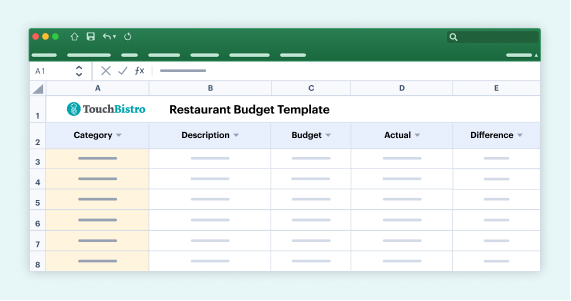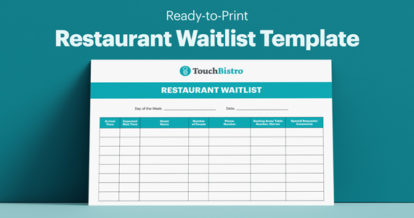Whether you have big dreams to open a restaurant or a vision for transforming your existing venue, money doesn’t need to stand in your way. There are numerous restaurant financing options you can pursue to bring your ideas to life.
In this complete guide to restaurant funding, we’ll cover:
- What restaurant financing is and reasons to apply for it
- How to finance a restaurant with 7 different funding sources
- What to know before applying for restaurant funding
What is Restaurant Financing?
Restaurant financing is money sourced (borrowed or loaned) by a restaurant from a lender such as a large national bank, small regional bank, the Small Business Administration (SBA), or an alternative financing source. This money is borrowed or loaned with interest.
The average small business loan in America is roughly $630,000, and the average interest rate on a small business loan is between 2.5% and 7%. The terms of restaurant financing options vary widely, with different repayment structures as well as other advantages and disadvantages. We’ll dig into the details shortly.
Why Do Restaurants Apply for Financing?
If you’re considering applying for financing, you’re not alone. In fact, full-service restaurants are the top recipients of SBA loans in particular, with nearly 30,000 restaurants receiving such loans in 2019. On top of that, nearly another 20,000 limited service restaurants received SBA loans that year, followed by the dental industry in third place.
There are various reasons why restaurant owners apply for financing and ultimately it’s a personal decision that differs for every restaurateur. Let’s walk through three of the most common reasons.
1. Opening A New Business
Opening a restaurant or bar is an exciting time, but it can also be nerve-wracking.
Let’s say you’re opening a bar in NYC – it costs money to get a bar up and running! You need a building, staff, equipment, a marketing budget, and, of course, drinks and food.
All the while, you’re in a highly competitive industry with low profit margins, which means it’s important to manage your finances carefully. This is especially true when you’re starting out and trying to gain traction in your market, which is why a restaurant loan is often a key ingredient in launching a new venture or expanding to another location.

Stay on top of expenses and manage costs with this restaurant budget template for Excel or Google Sheets.
2. Renovating Your Restaurant
Is it time for a new oven, walk-in fridge, or ventilation system? These are critical parts of a well-running commercial kitchen, and you don’t want to be operating with subpar equipment. This kind of kitchen equipment is pricey, so you may need some extra cash to help pay for it. That’s where restaurant equipment financing comes in.
Accessing this kind of funding is a fairly easy and straightforward way to get capital so you can pay for up to 100% of commercial kitchen purchases. This way, you won’t have to worry about expensive locally-sourced ingredients spoiling in a faulty fridge.
3. Rebranding Your Restaurant
If staring at the same logo your restaurant has had for the past 10 years is driving you bonkers, you may be itching to rebrand the business. This is a common part of a restaurant’s evolution, and it can have a positive impact on your reputation and your bottom line – but first, you need to shell out the cash for the rebrand.
The amount of money you’ll need depends on how extensive your rebrand is. Are you keeping the same brand colors, but changing the style of your logo and menu design? Or, are you gutting your entire venue and putting in new furniture? If it’s the latter, you may need restaurant financing. Let’s explore how to make it happen.

How to Get Financing for a Restaurant: 7 Options
When it comes to knowing how to finance a restaurant, there’s no single right way to approach it. Here are 7 options to consider depending on your situation.
1. Brick-and-Mortar Bank Loans
You may be able to secure a traditional bank loan for your restaurant from either a large national bank or a small regional bank. Brick-and-mortar bank loans from traditional lenders involve borrowing a certain amount of money for a specific time frame at a set interest rate. These loans often include an agreement that ends within a year and that requires monthly payments.
Benefits and Drawbacks
Small businesses typically receive an average of $593,000 from large banks and $146,000 from small banks. The potential to access a large amount of capital is one of the major perks of brick-and-mortar bank loans. Another benefit to these loans is that they often have lower interest rates than other options.
However, low approval ratings on traditional bank loans for restaurants are a drawback to this kind of financing. This is true of large banks in particular, which have a small business loan approval rate of under 14%. Even the approval rate for small bank loans is less than 20%.
In addition, banks usually request collateral from you as the restaurateur to secure your loan. This could be cash, stocks, or property. It’s not always possible for loan-seekers to come up with collateral, though. Getting a bank loan can also be especially tough if you’re just starting out. Be prepared for rejection by some lenders whose terms may stipulate that your restaurant needs to be open for at least a year to qualify.
2. Alternative Loans
Securing funding from alternative lenders is an attractive option for many restaurateurs. These kinds of lenders include online companies like OnDeck, Kabbage, LendingClub, Funding Circle, and more. Some alternative lenders offer loans as high as $500,000, but the average small business loan of this nature is between $50,000 and $80,000.
Non-traditional restaurant loans are generally quick to apply for and receive. Some are even accessible within 24 hours of applying online. Lending terms range from several months to years, and interest rates vary widely. Like a bank loan, alternative loans also consider your credit score when determining eligibility.
Benefits and Drawbacks
If you’re opening a new restaurant, you’ll likely have better luck getting funding from a non-traditional lender than a bank. You may even be able to access the loan without providing collateral since some alternative lenders will provide you with collateral equal to 50% of your loan. Another benefit to these kinds of loans for restaurants is that they have higher approval ratings than brick-and-mortar loans, at nearly 25%.
However, even non-traditional lenders will probably still require your restaurant to be open for 30 days to qualify, which can be a drawback for some new restaurateurs. In addition, the interest rates on these loans can be as high as a 99% annual percentage rate, which means you’ll likely want to pay the money off as quickly as you can – though you may not have this option if your lender penalizes early repayment, as some do.
3. Small Business Administration Loans
The SBA offers many financing options with an average of $417,000 and a maximum of $5 million loaned to business owners, but its Guaranteed Loan Programs are most relevant to restaurateurs.
If you’re looking at purchasing a building for your restaurant, the SBA’s 7(a) Loan Program is likely your best bet. This is the association’s most popular program. In contrast, if you’re looking to finance a large equipment purchase, the 504 Loan Program is probably your top choice. And, if you just need a small infusion of cash, the Microloan Program for startups provides up to $50,000 to get you going.
Benefits and Drawbacks
One of the major perks of SBA loans is that they generally offer higher approval ratings than both bank loans and alternative financing options. They also carry reasonable interest rates of between 5.5 and 8%. SBA loans don’t require an overly high credit score for you to qualify, either. You may be able to qualify with a score of 690 or higher.
Like any restaurant financing option, SBA loans have some disadvantages. If you’re seeking a loan over $25,000, the SBA will likely ask you for collateral in exchange for the funds, including investment assets. In addition, these loans take longer to get approved than alternative loans. You could be waiting anywhere from 30 to 60 days to find out if your application is approved.
4. Business Line of Credit
A line of credit is another way for restaurateurs to access money. Like a loan, a line of credit is known as bank-issued debt, and getting approval depends on your credit score among other factors. However, there is one big difference.
“Loans have a non-revolving credit limit, which means the borrower has access to the funds only once, then they make principal and interest payments until the debt is paid off,” according to Investopedia. “With a line of credit, the borrower receives a set credit limit – just like a credit card – and makes regular payments that include both principal and interest. Unlike a loan, the borrower has continuous and repeated access to the line of credit while it is active.”
Benefits and Drawbacks
The fact that a line of credit offers continuous access to funds may be an advantage for some restaurateurs – for example, those who want to make a series of smaller expenditures over a longer period of time rather than a major purchase on one occasion.
Keep in mind that lines of credit can be difficult to access in times when your finances aren’t healthy, so don’t wait until you need one before you apply for it. Get your line of credit in advance of any big spending you plan to do.
5. Merchant Cash Advance
A merchant cash advance (MCA) enables restaurants to receive funds against future payments. This kind of financing is best for businesses that need capital as soon as possible to cover short-term expenses or cash-flow shortfalls.
“With an MCA, a company gives you an upfront sum of cash that you repay using a percentage of your debit and credit card sales, plus a fee,” according to NerdWallet. “The traditional way an MCA is structured [is that the] provider automatically deducts a daily or weekly percentage of your debit and credit card sales until the advance is repaid in full.”
Benefits and Drawbacks
MCAs are usually approved quickly, and you can have the funds in as little as 24 hours. Plus, you could still be eligible if your business is a startup or you have poor credit, which often isn’t the case with other loans.
One concern surrounding MCAs is that some require a daily payment, which can be hard to keep up with. You’ll also want to avoid taking out more than one MCA at a time, since this kind of financing can bury you in high interest (we’re talking rates in the triple digits).
6. Family and Friends
Every individual feels differently about asking family and friends for money. And, everyone’s family and friends have varying amounts of wealth (and varying levels of willingness to lend it to others). So, this may or may not be a viable restaurant financing option for you.
If you decide to go down this road, agree on an amount you’re both comfortable with, as well as clear terms for the loan. How long will you take to pay the money back and will you pay interest? If so, how much? What will happen if you can’t pay the money back under the original terms?
Benefits and Drawbacks
One of the biggest benefits of borrowing from family or friends is that they may not expect you to pay interest on the funds, although this isn’t always the case as they can legally charge up to around 18% interest.
There can be serious drawbacks to borrowing from family and friends, too. These range from dealing with the logistics of borrowing small amounts of money from multiple people, to potentially running your relationship with them over it.
Keep in mind that from a legal perspective, you’ll want to get your loan agreement in writing in order for it to be enforceable and to protect both parties involved. And in the case of a family member or friend gifting you money for your restaurant, you may be required to account for this when you pay your taxes, depending on the amount.
7. Crowdfunding
Unlike seeking money from a single lender, crowdfunding enables you to source funds from a large group of individuals. This makes it an attractive option for grassroots or community-minded restaurants.
Online crowdfunding platforms allow you to share your pitch with a broad range of potential investors far and wide. They can then contribute funds right through the platform.
Benefits and Drawbacks
Crowdfunding is often a more efficient process than trying to get a bank loan, and by getting the word out to a large group, it doubles as marketing for your business and helps you gain loyal customers early on.
However, crowdfunding isn’t all fun and games. “If you don’t reach your funding target, any finance that has been pledged will usually be returned to your investors and you will receive nothing,” according to NI Business Info. “And, getting the rewards or returns wrong can mean giving away too much of the business to investors.”
What You Need Before Applying for Financing
Before applying for any source of restaurant funding, make sure you have a solid business plan, financial projections, and a budget drawn up long before you sit down with any lenders. Numbers provide a comprehensive picture of your financial situation, which is why lenders will want to look under the hood of your business and see restaurant budgets and other documents before they agree to loan you money.
Stumped on how to project your revenue and expenses? We’ve got four restaurant spreadsheets to help you do exactly that.

Create a full financial forecast with our easy-to-use templates.
We’ve now covered 7 restaurant financing options worth considering to help make your dreams of launching, rebranding, renovating, or expanding your business a reality. We can’t wait to see what’s next for your restaurant!
Download our free inventory template
Sign up for our free weekly TouchBistro Newsletter







